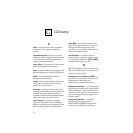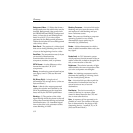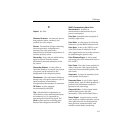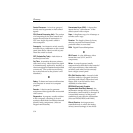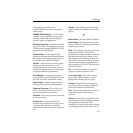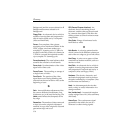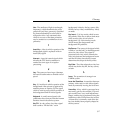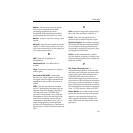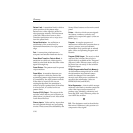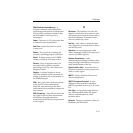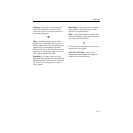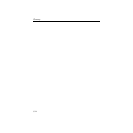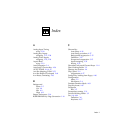
Glossary
G-8
Load: To transfer data to or from a storage
device.
Looping Input, Loop-through: An input that
includes two connectors. One connector
accepts the input signal, and the other
connector is used as an output for
connecting the input signal to another
piece of equipment or to a monitor.
Luminance: The quantitative attribute of
light, measured as luminous intensity.
Corresponds to the sensation of
brightness.
Luminance Key: A key effect in which the
portions of the key source that are greater
in luminance than the clip level cut the
hole in the background scene. In
luminance keying, any video (brightness)
level above the clip level will insert the
key; any level below the clip level will turn
the key off. In the key invert mode, this
clip relationship is reversed.
M
MII Format: A color difference video
format that uses the Y, R-Y, B-Y
components.
Macro: A function that provides for one
keystroke to take the place of many
keystrokes.
Mask: A pattern used to obscure parts of a
video key.
Mask Key: A key effect in which the keying
signal is masked (gated) by an adjustable
mask window that may be positioned
anywhere on the screen. The mask may be
set to force either foreground or
background as desired.
Matrix: (1) An array of input and output
signal lines whose intersections form
crosspoints. (2) The switcher frame with
circuit boards installed is sometimes called
the matrix because the circuit boards
contain several crosspoint switching
matrices.
Matte: An internally-generated flat color
signal which is adjustable for luminance,
hue, and saturation. Mattes may be used
to fill areas of keys and borders.
Matte Key: A key effect which employs a
matte as the fill signal.
M/E: An abbreviation for mix/effects.
Mix, Dissolve, Crossfade: A transition
between two video signals in which one
signal is faded down as the other is faded
up or in which one signal is faded in or out
over the other.
Mix/Effects (M/E): An electronic system
capable of processing video signals with
other video or control signals.
Mix to Pattern Limit: A transition limit in
which the pattern edge between two video
signals is set up with a lever arm and
stored in microprocessor memory.
Mixer: A control circuit in which two or
more input video signals are multiplied
with one or more non-video control
signals.




